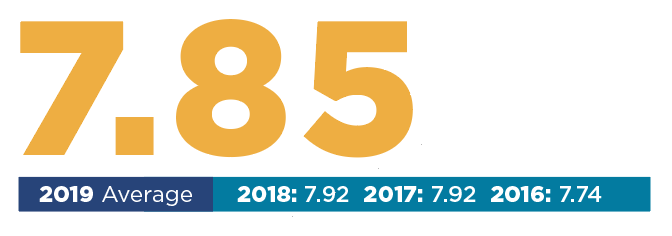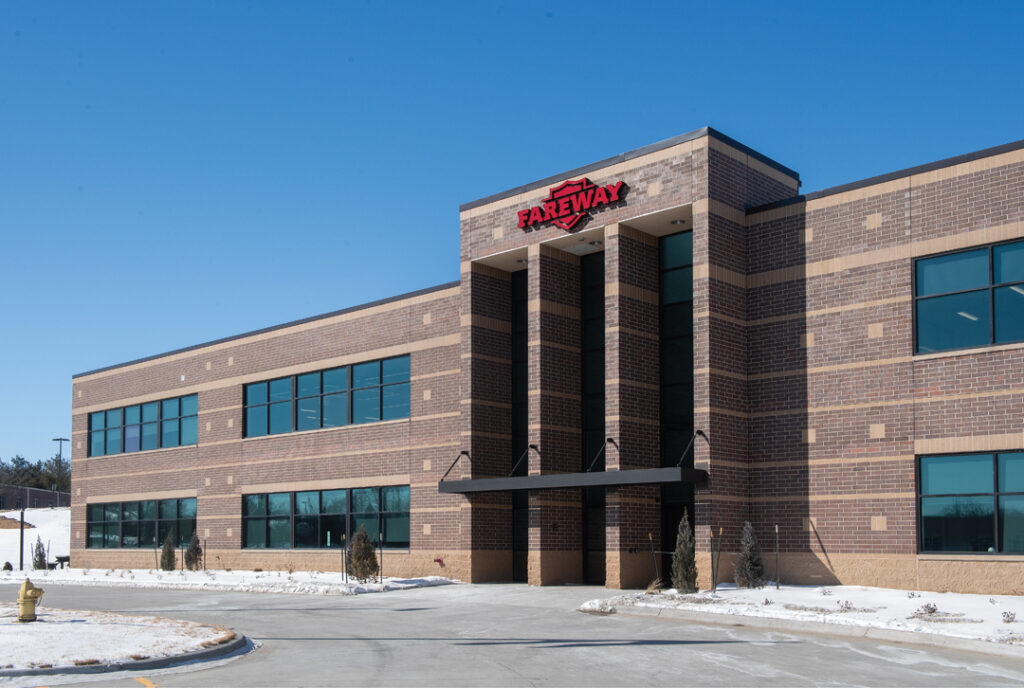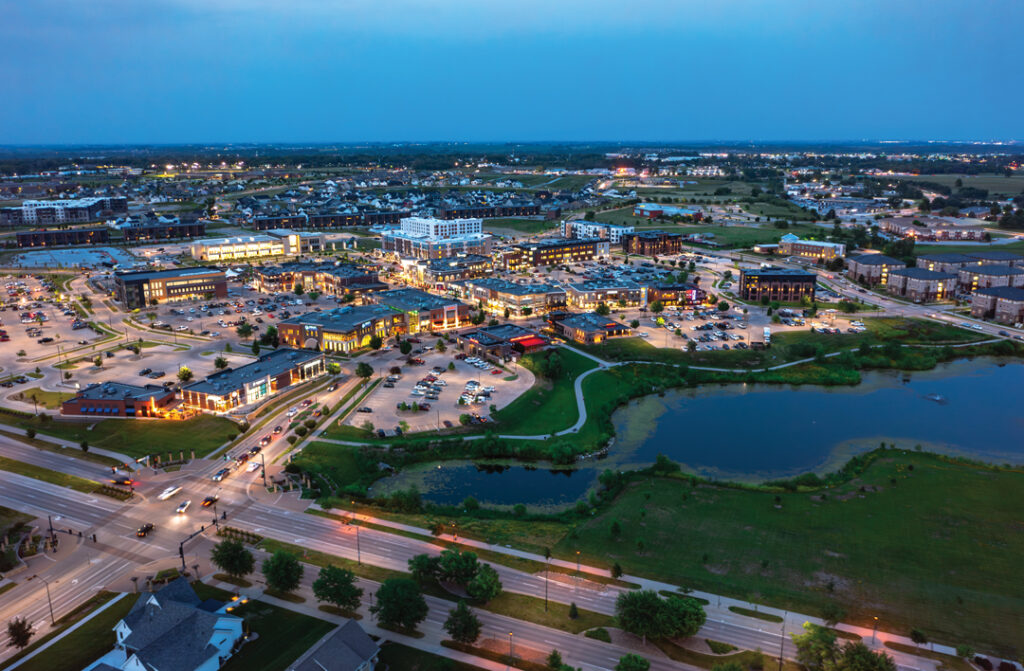2019 Leaders Survey
Child care, housing, light rail and more: A snapshot of where Des Moines business leaders stand on key issues

BUSINESS RECORD STAFF Nov 27, 2019 | 4:19 pm
16 min read time
3,881 wordsArts and Culture, Business Record Insider
Each year we get a pulse on key issues affecting the region’s business community from our audience of leaders. This is the eighth year the Business Record has asked for your thoughts.
We asked a variety of hard-hitting and lighthearted questions, but all of them help answer where is Greater Des Moines now and where is it going. Some survey questions carry over from year to year and provide a longer-term view. You’ll find comparisons to average responses from years past. Others are new this year, based on current events or trends in other metropolitan areas.
How the survey works: In October, we asked for your thoughts and you gave them in the survey. The form contained a mix of multiple-choice, ratings, true-or-false and short fill-in-the-blank questions. We’ve compiled the answers and collected comments on a few questions. These are just a snippet of the answers we received; we’ll include more in future coverage.
As always, we appreciate your participation with the Business Record and hope you gain insight from reading other perspectives. A special thanks to Dr. Teri Wahlig, CEO of ChildServe, who took the time to provide comprehensive analysis as our guest editor.
– Emily Barske, associate editor
Meet our Guest Editor
Dr. Teri Wahlig has served as the CEO of ChildServe, a specialty pediatric health care organization, since July 2018. She joined the organization in 2011 as vice president and medical director. Before joining ChildServe, Wahlig was medical director of MercyOne’s Neonatal Intensive Care Unit for 17 years.
An Iowa native, Wahlig was raised in West Des Moines and graduated from Dowling Catholic High School. She graduated from the University of Iowa College of Medicine and is board certified in pediatrics, neonatalology and palliative care. In 2015, Wahlig received her Master of Business Administration from the Henry B. Tippie College of Business at the University of Iowa. In 2018, the Iowa Hospital Association named Wahlig a Hospital Hero and the Des Moines Business Record named her a Women of Influence honoree.
Wahlig and her husband of 26 years, Mark Feldmann, a shareholder at the Bradshaw Fowler Procter & Fairgrave law firm, have resided in downtown Des Moines for nearly three decades.
Rate the overall health of the Central Iowa business community. (Scale of 1-10, 1 being weakest)
Guest Editor Dr. Teri Wahlig: “Ratings of 7.74 to 7.92 over the past four years show remarkable consistency. Iowans, by nature, are not boastful. Therefore, it doesn’t surprise me that we haven’t scored – and most likely won’t score – ourselves at a 9 or 10. The consistently high ratings demonstrate the Greater Des Moines business community is thriving.”
“The Central Iowa business community continues to thrive because of the overall diversity of products and services and the quality of the workforce. People here want to DO THINGS. They want to continue to grow. Don’t get me wrong – challenges exist, but generally I continue to believe in continued power of people to create and re-create opportunities.”
– James Beal, partner, RSM US LLP
“Active/dynamic. Good deals are getting done, and strategic growth is occurring. However, there seems to be a cautious tone for many companies.”
– Chris Sackett, managing partner, BrownWinick Law Firm
“Working in urban neighborhoods, there is much to be excited about; for instance, the Sixth Avenue Corridor improvements. There also seems to be an increasing number of people living on the margins, and this is concerning.”
– Stephanie Preusch, executive director, Neighborhood Finance Corp.
“Interest rates are low, unemployment is low, businesses are expanding and have more job openings than they have qualified applicants, and construction projects are plentiful, with over $4 Billion in projects either under construction or projected in the next 5-7 years.”
– Creighton Cox, manager of business development, Turner Construction Co.: Iowa
“Low unemployment creating a battle for talent and economic development projects that are future focused and include quality of life indicates good times.”
– Therese Wielage, VP marketing, Merchants Bonding Co.
Agree or disagree: Greater Des Moines has adequate child care/enough affordable child care options.
Guest Editor Dr. Teri Wahlig: “The data confirms this issue is a bright red flag. The vast majority of people who had an opinion said there are not adequate/affordable child care options. The U.S. Department of Health and Human Services defines child care as being affordable when it does not exceed 7% of family income. On average, a family making the state median income spends approximately 18% of their income to cover the cost of child care for an infant, and 13% for a toddler. That is a problem for all of us, but acutely so for those in the mid- to low-income bracket. The benefits of high-quality child care cannot be overstated. After parents, child care teachers have the most significant role in fostering child development. The benefits of high-quality, licensed child care also extend to parents and the wider society. It helps parents pursue their careers or attend school, and can have a long-term impact on families’ economic security.”
Disagree. “Demand exceeds supply in most cases, which has driven up child care costs to very high rates. This negatively impacts the workforce participation rate, as many are staying home to care for their children rather than working since the cost is so prohibitive and the ROI on working and paying for child care versus staying home with the kids is minimal, if any.”
– Drew Kamp, director of public policy, Ames Chamber of Commerce
Disagree. “My friends share that the moment they find out they are expecting, they have to call around to get their name on a daycare waiting list as soon as possible. This tells me that we don’t have enough child care options.”
– Angela Jiskoot, associate product manager, Pella Corp.
Disagree. “Working with a largely low-income population, this is an issue that comes up frequently.”
– Matt Unger, CEO, DMARC
Disagree. “My coworkers talk about how expensive child care is. More providers would hopefully decrease the price.”
– Holly Olson, VP finance and accounting, Anawim Housing Inc.
Disagree. “We are facing a child care crisis. I am grateful for the leadership of the United Way of Central Iowa and others on this issue, but we all need to be aware of the issue and supportive of the solutions.”
– Kristi Knous, president, Community Foundation of Greater Des Moines
Agree or disagree: Court Avenue and East Village should be designated as “go cup” areas where visitors can carry open alcoholic beverages from place to place.
Guest Editor Dr. Teri Wahlig: “One can appreciate the appeal of “go cups” adding to the festive environment, but significant challenges make this one tough to monitor and enforce. Maybe for events only.”
Disagree. “Too many irresponsible people and bad decisions.”
– Chris Sackett, managing partner, BrownWinick Law Firm
Agree. “To attract more business and incentivize the areas to look good outside as well as in the buildings.”
– Ben Wollner, engineer, CB Solar Inc.
Disagree. “Major problem policing.”
– Tim Dwight, owner, Integrated Power Contracting LLC
Disagree. “Have seen this play out in Savannah, GA.”
– Nicole Schleif, chief development officer, Boys & Girls Clubs of Central Iowa
Agree. “Areas that attract tourists in significant numbers (New Orleans and Savannah for example) do this and it works very well.”
– Drew Kamp, director of public policy, Ames Chamber of Commerce
Which of these attractions would you want the most in downtown?
Guest Editor Dr. Teri Wahlig: “Any public event that uses the water trails features would be a huge draw for downtown and be as much fun for participants as spectators.”
Agree or disagree: There is the right mix of renter and owner-occupied housing downtown.
Guest Editor Dr. Teri Wahlig: “Of the people who have an opinion (agree or disagree) it seems evenly split. I have lived downtown for more than 25 years – and the growth in rental units over the last four years has been phenomenal. We may not know for several years whether the mix is right or not. The growth in housing downtown is truly remarkable. We have become a city. Downtown is alive.”
Disagree. “Having worked in the industry at four downtown rental communities, I believe there are significantly more renters downtown than owners.”
– Angie Berhow, solar energy sales manager, 1 Source Solar
Agree. “There just needs to be more of both that are affordable to those working downtown.”
– Stephanie Preusch, executive director, Neighborhood Finance Corp.
Disagree. “It seems like the vast majority of new housing is only available to rent instead of purchase.”
– Derek Sadler, partner, Current RE
Disagree. “Being recently in the market, I found too few units available for purchase and pricing on rentable units to be higher than anticipated.”
– David Hyatt, president, Iowa Speedway
Agree. “Generally agree — the sheer amount of housing has needed to increase dramatically over the past decade and I’m very impressed by how much has come available.”
– Mitch Van Kley, controller, Iowa Bankers Insurance & Services
How stressed are you feeling at work? (Scale of 1-10, 1 being not very stressed)
Guest Editor Dr. Teri Wahlig: “For some, stress is the other side of the energy coin — it propels them. However, the data on stress is alarming. More and more people report higher levels of stress leading to physical, emotional and mental illness. Jeffrey Pfeffer from the Stanford Graduate School of Business reports that stress results in an 8% increase in annual health care costs and 20,000 excess deaths per year. The indirect costs of stress, such as disengagement and distraction from work, are estimated to be five times greater than the health care costs. Fortunately, the anecdote is within everyone’s grasp. Improving workplace culture through compassion, kindness and (dare I say it) love increases resiliency, engagement and well-being.”
On average, how many hours per week are you working?
Guest Editor Dr. Teri Wahlig: “I am surprised the average was not higher. With 24-hour connectivity due to cellphones, tablets and other electronic devices, we have blurred the line between office and home. We now carry the office in our pocket, so in some sense we are always working.”
If you were to create a Raygun T-shirt, what would it say?
“Come for the fair, stay for the people.”
– Joann Tucker, Legal administrator, McKee, Voorhees & Sease PLC
“Iowa – yes, it’s heaven.”
– Jeff Rose, president and CEO, American Bank & Trust
“Des Moines: You got insurance?”
– Andy Schryver, director of membership services, Better Business Bureau
“#DSMUSA: While you were flying over, we passed you by!”
– Tony Dickinson, VP, COO, NCMIC
“Des Moines. Slide into our DMs.”
– Lindy Ireland, vice president, BCC Advisers
Which destination would you most like to add to Des Moines International Airport’s all-year direct flights?
Guest Editor Dr. Teri Wahlig: “First, we should recognize the tremendous expansion of travel from the DSM airport. Over the past eight years, six destinations have been added. Passenger growth has averaged a 5% increase each year since 2009, with projected passenger numbers surpassing 2.9 million in 2019 – indicating air travel is big business. I have it on good authority that for business travel a likely new destination is either San Francisco or Los Angeles – and for leisure, perhaps Miami. However, the surprise could be a direct route to San Jose, which would also work for the San Francisco market.”
Agree or disagree: The water trails plan proposed by the Central Iowa Water Trails Incubator will be worth the $100 million-plus investment.
Agree. “Investment in public infrastructure is usually a good idea. Iowa provides fantastic attractions for residents and visitors alike, but diversifying our outdoor recreational options would be a bold commitment to embrace our downtown riverfront.”
– Matthew Mitchell, strategy professor and partner, Drake University and Bâton Global
Agree. “The Central Iowa Water Trails project will be successful and will be a huge game changer for business attraction, workforce attraction and retention, improved water quality and enhanced quality of life. We should join together to make it happen. I simply can’t wait!”
– Kristi Knous, president, Community Foundation of Greater Des Moines
Agree. “This is the one major project we can invest in that will have the greatest impact on attracting and retaining talent in our region.”
– Rick Tollakson, CEO, Hubbell Realty Co.
FILL IN THE BLANK: The biggest issue facing Iowa businesses right now is _______.
Guest Editor Dr. Teri Wahlig: “Attracting talent – the workforce of tomorrow. Iowa has been planful in developing excellent educational institutions, vibrant cities and a strong business community. Leveraging our strengths through collaboration and commitment to the future will continue to keep Iowa rising.”
“The biggest challenge facing Iowa is the need to prepare for change within their industries. In our office, we have a motto that rings true for many organizations in our community: ‘This very moment is the slowest pace of change you will experience in the rest of your life.’ – Lippincott, The Innovator’s Playground. We live in a generally conservative geography that is dominated by industries that have historically been risk-averse (e.g., insurance, agriculture, etc.). As a result, many companies aren’t prepared for a more digital, dynamic, data-driven competitive landscape.”
– Matthew Mitchell, strategy professor and partner, Drake University and Bâton Global
“The biggest issue facing Iowa businesses right now is finding talent/workforce, and in order to meet that need we need to ensure adequate affordable housing and transportation options for all.”
– Elizabeth Presutti, chief executive officer, Des Moines Area Regional Transit Authority
“Legislation catering to big business at the cost of small business.”
– Ben Wollner, engineer, CB Solar Inc.
“Farm income going down. Second is more locally owned businesses being bought out and losing local philanthropy.”
– Gary Mathems, consultant
“Development, investment in housing and livability enhancements outpacing population growth.”
– James Beal, partner, RSM US LLP
“Enough tech talent. Need increase in educational resources to prepare talent locally. Need environmental (especially clean water) focus to attract those from communities on the coasts and in the mountains.”
– Kerty Levy, CEO, KNLWorks
Agree or disagree: Greater Des Moines should have a light rail system for commuters.
Guest Editor Dr. Teri Wahlig: “A light rail system would be cool; however, unless we are solving a commute problem, this type of system may not be the answer. Des Moines has low population density; we simply are not moving many people from one place to another – yet. Light rail provides group transportation over a fixed route. I wonder if that may not happen via autonomous pod vehicles in the near future instead.”
Agree. “Attracting a broader talent pool is inhibited by the poor public transportation to the suburbs as the metro grows.”
– Kellee Mullen, project lead, Visionary Services
Agree. “It is getting way too congested – and at all times throughout the day. More and more housing keeps going up in Grimes, Ankeny, Waukee … and they all have to travel elsewhere for work. Rush hour traffic is becoming unbearable.”
– Angie Berhow, solar energy sales manager, 1 Source Solar
Disagree. “Not large enough and a very light rush hour issue in our metro. What we need is a better North/South expressway or limited access parkway cutting through the area — North/South travel is burdensome especially in the Northwest part of Des Moines proper leading north to Northwest suburbs.”
– Joel Hanson, president and founder, Hanson Commercial Finance & Consulting
Agree. “Bus Rapid Transit and Streetcar systems are mobility and economic development strategies that have been implemented in peer Midwest cities like Grand Rapids, Tulsa, Oklahoma City, etc. The region will need to consider value of these types of investments as we look to the future to maintain our economic competitiveness.”
– Elizabeth Presutti, chief executive officer, Des Moines Area Regional Transit Authority
I’m not sure. “It depends on where the routes are placed, and if they are connected to a larger commuter system including Omaha, Iowa City and Chicago. I don’t believe the metro has the population or the financial capacity that allows a light rail system to be created yet.”
– Creighton Cox, manager of business development, Turner Construction Co.: Iowa
Agree. “Relieve congestion on 80/35 and 235 and provide reliable workforce transit. Needed from DSM all the way to Ames.”
– Drew Kamp, director of public policy, Ames Chamber of Commerce
Disagree. “I don’t see that it would be used frequently. Our population and workforce are fairly decentralized. For this to work, you need people going from one place to another en masse. Commutes are short as-is in Des Moines.”
– Mitch Van Kley, controller, Iowa Bankers Insurance & Services
Agree. “I agree, but not anytime soon. I think this is something that should be considered for when the Metro hits one million residents. We do not have the need for this type of transportation yet.”
– Andy Schryver, director of membership services, Better Business Bureau
Agree or disagree: Artificial intelligence will reduce the number of jobs available by 2040.
Guest Editor Dr. Teri Wahlig: “AI will definitely change jobs by 2040 — hard to predict how it will affect the total number. AI will likely decrease many jobs in agriculture, transportation and e-commerce, but may create business opportunities in other areas. Companies will need to focus on retraining the workforce, continuous learning and adapting to dynamic change.”
Disagree. “Artificial intelligence will impact the makeup of jobs within our company, but ultimately there will be a net gain in jobs created versus those destroyed. AI is not something to fear. AI will shift many jobs in agriculture, transportation, e-commerce and even government, but it will create innumerable business opportunities in new, innovative areas. Companies will need to focus on reskilling their workforce and ensuring leadership is ready to embrace a culture of learning and dynamic change.”
– Matthew Mitchell, strategy professor and partner, Drake University and Bâton Global
Agree. “Banking has already become quite automated. AI is already utilized in compliance to stratify data and in our lending decisioning and pricing models. While we will need fewer FTEs [full-time equivalents] in the future, more will be expected from those employees, and their wages will be significantly higher for the value added versus those being replaced.”
– Jeff Rose, president and CEO, American Bank & Trust
Disagree. “Though current jobs may be eliminated, they will be replaced with other options like they always are.”
– Tony Raymer, director of clinical and community services, Candeo
Disagree. “I am hopeful that AI will supplement the need and reduce the number of open positions to help ease the burden of labor shortages.”
– Shannon Strickler, president/CEO, LeadingAge Iowa
Agree. “AI doesn’t pay into Social Security or health care.”
– John Hambrecht, account executive, Aspen Waste Systems
Agree or disagree: The Greater Des Moines business community would be better off overall and more attractive to businesses and residents with a singular metro government in the area.
Guest Editor Dr. Teri Wahlig: “A plan to merge the governments of Des Moines and Polk County was rejected by voters in 2004. This city-county government consolidation would have consisted of a full-time mayor and a 15-member council representing the city and its suburbs. Although a full merger was soundly rejected at that time, many city and county departments and programs have been consolidated. In this survey, there does not seem to be widespread support for consolidated government, so perhaps we should focus our efforts on increased cooperation, like regionalization of the Water Works Board.”
I’m not sure. “A particular structure for governance does not necessarily mean good governance.”
– Paul Hayes, president, JSC Properties Inc.
Agree. “While it’s a tough argument, the regional authorities that have been set up are efficient and working.”
– Kevin Crowley, COO/manager, NAI Iowa Realty Commercial
Disagree. “There is a benefit to combining some services and having regional utility governance, but each community has their own strengths and personalities. There are specific reasons why businesses and residents choose one community over another, and I know a part of that is the distinct differences between governments, including taxes, administration, infrastructure and amenities.”
– Creighton Cox, manager of business development, Turner Construction Co.: Iowa
Agree or disagree: Developers should be required to have an affordable housing component to receive public tax incentives.
Guest Editor Dr. Teri Wahlig: “When thinking about affordable housing for families, we cannot simply look at the cost of housing alone. We must evaluate the cost of living for each household – the cost of food, clothing, child care, housing and more. If you look at the cost of these combined expenses, housing affordability is a fundamental problem. I would prefer to incentivize developers rather than mandate. I am not sure a one-size-fits-all rule is helpful.”
Agree. “That’s the basis of taking public financing. The public part of it.”
– Gary Mathems, consultant
I’m not sure. “The goal of more affordable housing is admirable and needed. However, I would hate to lose other/needed development because we attach an unfeasible/unrealistic affordable housing component. I think maybe it should be A factor, but not THE factor.”
– Chris Sackett, managing partner, BrownWinick Law Firm
I’m not sure. “We do not have enough affordable housing in the Des Moines metro area. However, I am not sure that requiring all developers to have an affordable housing component to receive public tax incentives is the answer. I do think that in the right situations this could work if certain parameters were met. Although many individuals in our community are working multiple jobs, with the lack of affordable housing options, they end up on the street or staying with family or friends. This is shown in our community with an increase in the homeless population and overcrowding in shelters. I would like to see more done to ensure there are affordable living options in our community.”
– Angela Jiskoot, associate product manager, Pella Corp.
Disagree. “It will require a strong public-private partnership to identify and carry out opportunities for the development community to help meet the affordable housing needs of the community. At the same time, forcing the requirement would likely lead to unintended consequences.”
– Chris Costa, president, Knapp Properties
Agree. “Housing costs as a percentage of income seem to be out of whack. There are a number of issues that need to be impacted to change our poverty-scape in greater DSM, but having enough affordable housing, in the right places, is ONE thing that would help in that regard.”
– Matt Unger, CEO, DMARC
Agree. “Affordable Housing and increasing the skilled workforce are my number one and two items of concern in Central Iowa, and they go hand in hand. The metro, and more specifically the suburbs, are not supplying affordable housing options to the workforce. Our employees, citizens, young professionals and seniors need housing options. I lived in an affordable housing complex my first year out of college, and when I surpassed the income qualifications, I volunteered out to let the next resident in. Affordable housing helped me when I needed it, and I feel our developers and communities should be helping those that need it now too, especially if they get public incentives.”
– Creighton Cox, manager of business development, Turner Construction Co.: Iowa























